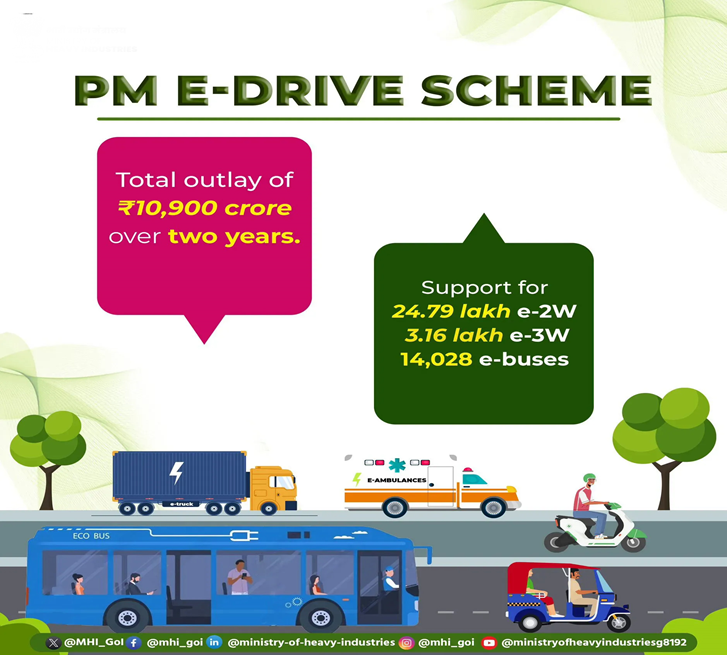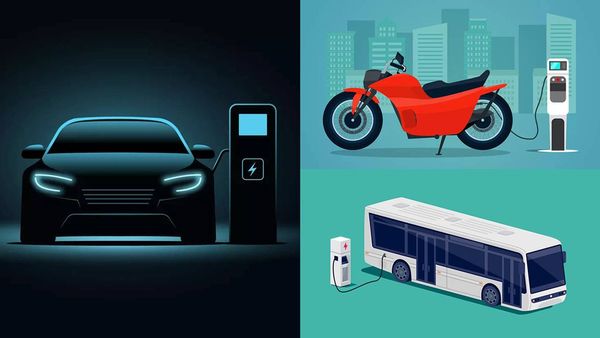Context:
The Ministry of Heavy Industries, Government of India has launched the 'PM Electric Drive Revolution in Innovative Vehicle Enhancement (PM e-DRIVE) Scheme under Gazette Notification SO 4259 (E) dated 29th September, 2024 with the approval of the Union Cabinet chaired by the Prime Minister Shri Narendra Modi. The Scheme will be implemented from 1st October, 2024 to 31st March, 2026.
· Further, the expenditure under EMPS-2024 for e-2W and e-3W being implemented for the period from 1st April, 2024 to 30th September, 2024 is being subsumed under PM e-Drive Scheme.

Key Features of the Scheme:
1. Replacement of FAME II:
o The Pradhan Mantri Electric Mobility Drive (PM e-Drive) replaces Phase II of the FAME II scheme, aiming to promote the usage and manufacturing of electric vehicles (EVs) in India.
o The expenditure under EMPS-2024 for e-2W (electric two-wheelers) and e-3W (electric three-wheelers), implemented from 1st April 2024 to 30th September 2024, is subsumed under the PM e-DRIVE scheme.
2. Financial Outlay:
o Total Budget: ₹10,900 crore over two years
o The scheme aims to create a supportive environment for the EV industry, reducing dependence on fossil fuels and encouraging environmentally friendly transportation.
Key Components and Allocations:
1. Subsidies and Incentives:
o Financial Support for Manufacturers and Buyers: the government will offer a variety of incentives to both electric vehicle manufacturers and buyers, including subsidies, tax exemptions, and reduced registration fees for electric vehicles.
§ Subsidy for EVs:
§ A demand incentive of ₹3,679 crore is earmarked to promote the adoption of electric two-wheelers (e-2W), electric three-wheelers (e-3W), electric ambulances (e-ambulances), electric trucks (e-trucks), and other emerging electric vehicles.
§ The scheme will assist in the sale of approximately:
§ 24.79 lakh e-2W (electric two-wheelers)
§ 3.16 lakh e-3W (electric three-wheelers)
§ 14,028 e-buses
2. E-Voucher: This voucher will be used to avail demand incentive and will be authenticated by Aadhaar.
3. E-Ambulance: Rs 500 crore allocated for deployment of electric ambulances to promote green healthcare solutions.
4. E-Buses: Rs 4,391 crore has been allocated for the purchase of about 14,028 e-buses by state transport undertakings and public transport agencies.
5. E-Trucks: Rs 500 crore has been allocated to promote e-trucks. Which will play an important role in controlling air pollution caused by trucks in general.
6. Charging Infrastructure: A strong network is to be created by setting up Electric Vehicle Public Charging Stations (EVPCS) in selected cities, areas and highways across the country.
7. Technology Development: Testing agencies will be modernized to deal with new and emerging technologies to promote green mobility. For example, the focus is on making electric vehicles (EV) more efficient and economical by promoting research in battery technology, charging systems and vehicle design.
Impacts:
1. Achievement of Net Zero Target:
o The PM e-DRIVE Scheme has the potential to play a crucial role in helping India achieve its net zero emissions target by 2070. By promoting electric mobility, the scheme will reduce greenhouse gas emissions from the transportation sector, which is one of the largest contributors to air pollution in India.
2. Reduction in Air Pollution:
o The deployment of electric trucks (e-trucks) and e-buses will lead to a significant reduction in air pollution and greenhouse gases, particularly in urban areas. E-trucks will help mitigate the pollution caused by diesel-powered freight trucks, while e-buses will contribute to cleaner and more sustainable public transportation.
3. Boost to Public Mobility:
o The introduction of 14,028 e-buses will boost public transportation in cities, providing a cleaner and more efficient mode of travel for the general public. This move will also help reduce traffic congestion and the overall environmental impact of conventional buses.
4. Domestic Manufacturing and Phased Manufacturing Program (PMP):
o The scheme includes a Phased Manufacturing Program (PMP) designed to promote domestic manufacturing and the development of a local supply chain. By encouraging local production, the government aims to create job opportunities, foster innovation, and attract international investment, thereby strengthening the Indian economy.
5. Reduction in Fossil Fuel Dependence:
o The PM e-DRIVE Scheme will reduce India’s dependence on fossil fuels for transportation. This will not only help India meet its environmental goals but also reduce the country's sensitivity to fluctuations in global oil prices, thereby strengthening energy security.
Challenges:
1. High Battery Costs: Despite the financial incentives, the price of electric vehicles in India remains relatively high due to the high cost of batteries. The cost factor may limit widespread adoption, particularly among price-sensitive consumers.
2. Electricity Production from Coal: A significant proportion of India’s electricity is still generated by burning coal, which limits the environmental benefits of electric vehicles. To fully realize the potential of EVs, the country needs to shift toward renewable energy sources for electricity production.
3. Limited Charging Infrastructure: The current charging infrastructure in India is underdeveloped, and without adequate charging facilities, the convenience and usability of electric vehicles are limited. The expansion of public charging stations is critical for the successful adoption of EVs.
4. Battery Safety and Performance: Issues related to battery safety and performance remains a concern, particularly in extreme weather conditions. Consumers need confidence in the safety and longevity of EV batteries to consider making the switch from conventional vehicles.
5. Supply Chain Vulnerabilities: India relies heavily on imports for critical raw materials like lithium and cobalt, which are essential for manufacturing EV batteries. This dependence on imports exposes the country to potential supply chain disruptions and price volatility.
Potential Solutions:
1. Private Sector Participation: The government can encourage greater participation from the private sector in the development of EV infrastructure, technological innovation, and manufacturing processes. Private investment can help overcome some of the financial and technological challenges currently faced by the EV industry.
2. Domestic Lithium Reserves: States like Telangana have the potential to become hubs for EV manufacturing, leveraging lithium reserves found in Jammu and Kashmir. By utilizing these domestic resources, India can reduce its reliance on imported raw materials and build a more resilient supply chain for EV batteries.
3. Securing Lithium Resources: India is actively pursuing international partnerships to secure lithium resources, which will be essential for meeting the growing demand for lithium-ion batteries. By securing these resources, India can ensure stable prices and a consistent supply of key battery components.
Conclusion:
The PM e-DRIVE Scheme represents a significant step towards promoting electric vehicles in India. Through financial incentives, infrastructure development, and technological advancement, the scheme aims to address key environmental concerns and reduce the country’s dependence on fossil fuels. By fostering innovation, encouraging local manufacturing, and raising public awareness, the scheme has the potential to create a thriving EV ecosystem. While challenges remain, such as high battery costs and limited charging infrastructure, with the right policies and private sector collaboration, India can overcome these obstacles and move toward a greener, more sustainable future.
|
Probable questions for UPSC Mains exam: What are the potential benefits and challenges of electric vehicle (EV) adoption in India as envisaged under the PM e-DRIVE Scheme? Discuss the importance of developing domestic EV supply chains, including battery manufacturing. |








